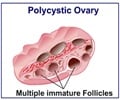How the daughters develop in their mother’s womb can be an indication of how they may be at risk from developing polycystic ovarian syndrome.
Polycystic ovarian syndrome is a condition that affects about 10% of the women in the childbearing age. This condition is characterized by high levels of male hormones called androgens, with irregular or no menstrual cycles, and with presence or absence of small cysts in their ovaries. The syndrome may affect the women’s health and cause problems in menstrual cycle and fertility, hormonal imbalance, insulin production, cardiovascular problems, and physical appearance.Researchers from University of Adelaide, Australia, had reported at the 21st annual conference of the European Society of Human Reproduction and Embryology that pregnancy and childbirth can unleash several factors in female fetus that can affect the incidence and intensity of polycystic ovarian syndrome when they grow to their adulthood.
Researchers suggest that several developmental pathways affecting the fetus may be responsible for the incidence of polycystic ovarian syndrome in daughters later in life. One such pathway may be the incidence of high maternal bodyweight in late pregnancy that can lead to irregular periods in daughter. This may in turn lead to daughters being overweight and have other weight related problems. Like this there are other developmental pathways that may get affected enough to cause polycystic ovarian syndrome in daughters in their adult life.
Reference: European Society of Human Reproduction and Embryology, news release, June 2005 , polycystic ovarian syndrome, mother’s womb, pregnancy and childbirth, female fetus, high maternal bodyweight, developmental pathways, androgens, irregular or no menstrual cycles









